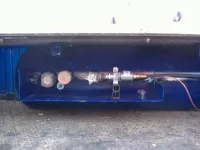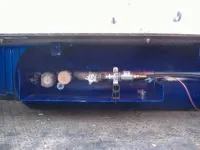Propane Conversion Tech Write-Up
CJim7
Crazy Sr. Respected Jeeper
- Posts
- 3,590
- Thanks
- 4
- Location
- Twin Falls ID
- Vehicle(s)
- '84 CJ7 - 430hp 401 on propane - T18a/D300 twinsticked, Superior axles, Lockers, full boatsides, Warn 8274, OBA, 36" TSL's.
For those of you wondering if I was ever going to get around to the write-up I promised...well, here it is 
If CJ feels this should be in a different forum, he is more then welcome to move it appropriately. After all, it IS his site
There are 3 basic components to my propane setup. Not counting tanks and lines, they consist of a vaporizer/mixer, carburetor, and a vacuum controlled cutoff switch. Before I get into the particulars, it is important to note that this is a pieced together system with 3 different companies involved. For anyone doing the conversion, I highly recommend going with a complete kit from someone like Gotpropane.com. They are the premier outfitters for propane conversions and their customer service and support are unparalleled.
The first piece to this puzzle is the carburetor. I am using an Impco model (450 I believe it is) and a chevy square bore throttle plate. The carb is stupid simple and possesses nothing more then a jet, butterfly valve, and vacuum ports for advance and such. There is no choke.
The picture below shows my old Quadrajet on the right and the new Impco propane carb on the left. The carb utilizes a spring loaded vacuum operated door system to let air into the intake during startup and operation. When the engine is off, the door completely seals up from the outside air. The carb also utilizes a standard vacuum system for vacuum advance as well as any other vacuum operated equipment...more on that later.

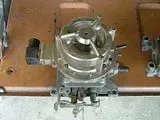
The next couple of shots is the carb mounted to my Edelbrock manifold. Fitment was a piece of cake and it takes up less room and looks less trashy then my old Quaddrajet.....a much sleeker unit to be sure.
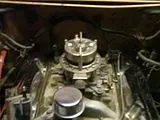
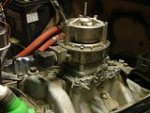
Any aftermarket air cleaner will work on this as well as stock Quadrajet air cleaners. Do not use a raised cleaner assembly however as it will impede the flow of air to the intake opening. They are usually raised from the neck up and that is where the restriction will take place.
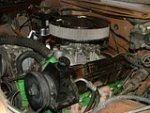
The next photo is the Woodward vacuum cutoff (small unit on the right) and the OHC Model X-1 vaporizer/mixer on the left. The mixer is the most important part of the conversion. It's job is to turn pressurized propane into a gas form and lower the pressure to a usable psi. The mixer also needs to keep from freezing up so it is fitted with a coolant bladder which utilizes the engine's own radiator fluid. I ran my heater return hose from the heater core to the inlet and then back to the intake manifold. There are a couple of ways to do this, but using the existing heater hoses is the easiest.
The mixer has an atmospheric pressure diaphragm in it and needs to be regulated by outside source...therefore it has a small filter on it to keep pressure equal to the outside air.
The fuel cutoff is just that. It is a safety precaution that only allows propane to enter the mixer/vaporizer when the engine is running or being started. It operates by vacuum from the carburetor, a simple vacuum line from a port to the cutoff. This is a Woodward model vacuum cutoff switch. There are also electrical units, but I like the efficiency and simplicity of the vacuum system.
I mounted both inline on the passenger side fender to keep it close to the heater lines.
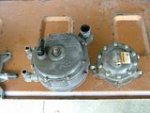
I used two 8 gallon forklift tanks as my fuel source. I have them mounted where the rear seat used to be with brackets to the floor. It is very important to note that propane tanks should never be mounted outside of the role cage...such as under the vehicle or outside of the tub. Because they are pressurized, they are extremely susceptible to being punctured. Once that happens, it not only becomes a huge safety risk, but you run out of fuel rather quickly.
As a side note, I removed my old gastank and that created a huge amount of clearance at the backend. Also gone is the charcoal canister and old fuel lines.
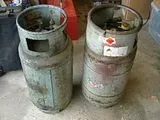
The last photo shows the brackets and the fuel line. The line runs from the tanks up to my firewall and into the engine compartment where it connects directly with the cutoff switch.
Valving can be built so that a manual or electrical switch of the tanks can be made without unhooking the line and hooking it back up to a full tank. Im in the process of building a manifold system for mine as we speak.
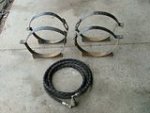
Now you're wondering what do do with the mechanical fuel pump. I removed it and built a simple cover plate, used a fuel pump gasket, and bolted it up...further eliminating even more lines.
That's really all there is. Tuning is very easy, but Propane requires more advanced timing...Im running 16 degrees advanced and it could use more. Another thing propane likes is high compression. When I built my 401, I went with high compression flat pistons and a cam to take advantage of it. Stock engines can take propane, it's just ideal to run a higher compression if possible.
Propane offers about the same MPG or better as gasoline for the simple fact that it is replacing an outdated gas carb. I found I got slightly better mileage with the propane. Power is another question mark. Theories state you will notice less power, but again, it is compared to an outdated gas carb. In my case I gained power and torque mainly because of the compression i run. The quadrajet I had before ran flawlessly.
Propane burns incredibly clean. The only emmisions are water vapor and CO2...You can almost breath it. The effects on the internal engine components are also desirable. Because propane is at the low end of the carbon scale, there is no buildup or depositing of carbon in the engine. My oil looks perfectly clean at the time I change it.
Another plus is propane lowers the operating temperature of the engine. My 401 runs 15 degrees cooler then when it was on gasoline. For an engine that tends to run hot anyways in stock form, this is a great help.
Stay away from dual systems. Although they are useful because of the diversity of being able to run both gas and propane, they rob power from both. A stand alone system is the way to go.

If CJ feels this should be in a different forum, he is more then welcome to move it appropriately. After all, it IS his site

There are 3 basic components to my propane setup. Not counting tanks and lines, they consist of a vaporizer/mixer, carburetor, and a vacuum controlled cutoff switch. Before I get into the particulars, it is important to note that this is a pieced together system with 3 different companies involved. For anyone doing the conversion, I highly recommend going with a complete kit from someone like Gotpropane.com. They are the premier outfitters for propane conversions and their customer service and support are unparalleled.
The first piece to this puzzle is the carburetor. I am using an Impco model (450 I believe it is) and a chevy square bore throttle plate. The carb is stupid simple and possesses nothing more then a jet, butterfly valve, and vacuum ports for advance and such. There is no choke.
The picture below shows my old Quadrajet on the right and the new Impco propane carb on the left. The carb utilizes a spring loaded vacuum operated door system to let air into the intake during startup and operation. When the engine is off, the door completely seals up from the outside air. The carb also utilizes a standard vacuum system for vacuum advance as well as any other vacuum operated equipment...more on that later.


The next couple of shots is the carb mounted to my Edelbrock manifold. Fitment was a piece of cake and it takes up less room and looks less trashy then my old Quaddrajet.....a much sleeker unit to be sure.


Any aftermarket air cleaner will work on this as well as stock Quadrajet air cleaners. Do not use a raised cleaner assembly however as it will impede the flow of air to the intake opening. They are usually raised from the neck up and that is where the restriction will take place.

The next photo is the Woodward vacuum cutoff (small unit on the right) and the OHC Model X-1 vaporizer/mixer on the left. The mixer is the most important part of the conversion. It's job is to turn pressurized propane into a gas form and lower the pressure to a usable psi. The mixer also needs to keep from freezing up so it is fitted with a coolant bladder which utilizes the engine's own radiator fluid. I ran my heater return hose from the heater core to the inlet and then back to the intake manifold. There are a couple of ways to do this, but using the existing heater hoses is the easiest.
The mixer has an atmospheric pressure diaphragm in it and needs to be regulated by outside source...therefore it has a small filter on it to keep pressure equal to the outside air.
The fuel cutoff is just that. It is a safety precaution that only allows propane to enter the mixer/vaporizer when the engine is running or being started. It operates by vacuum from the carburetor, a simple vacuum line from a port to the cutoff. This is a Woodward model vacuum cutoff switch. There are also electrical units, but I like the efficiency and simplicity of the vacuum system.
I mounted both inline on the passenger side fender to keep it close to the heater lines.

I used two 8 gallon forklift tanks as my fuel source. I have them mounted where the rear seat used to be with brackets to the floor. It is very important to note that propane tanks should never be mounted outside of the role cage...such as under the vehicle or outside of the tub. Because they are pressurized, they are extremely susceptible to being punctured. Once that happens, it not only becomes a huge safety risk, but you run out of fuel rather quickly.
As a side note, I removed my old gastank and that created a huge amount of clearance at the backend. Also gone is the charcoal canister and old fuel lines.

The last photo shows the brackets and the fuel line. The line runs from the tanks up to my firewall and into the engine compartment where it connects directly with the cutoff switch.
Valving can be built so that a manual or electrical switch of the tanks can be made without unhooking the line and hooking it back up to a full tank. Im in the process of building a manifold system for mine as we speak.

Now you're wondering what do do with the mechanical fuel pump. I removed it and built a simple cover plate, used a fuel pump gasket, and bolted it up...further eliminating even more lines.
That's really all there is. Tuning is very easy, but Propane requires more advanced timing...Im running 16 degrees advanced and it could use more. Another thing propane likes is high compression. When I built my 401, I went with high compression flat pistons and a cam to take advantage of it. Stock engines can take propane, it's just ideal to run a higher compression if possible.
Propane offers about the same MPG or better as gasoline for the simple fact that it is replacing an outdated gas carb. I found I got slightly better mileage with the propane. Power is another question mark. Theories state you will notice less power, but again, it is compared to an outdated gas carb. In my case I gained power and torque mainly because of the compression i run. The quadrajet I had before ran flawlessly.
Propane burns incredibly clean. The only emmisions are water vapor and CO2...You can almost breath it. The effects on the internal engine components are also desirable. Because propane is at the low end of the carbon scale, there is no buildup or depositing of carbon in the engine. My oil looks perfectly clean at the time I change it.
Another plus is propane lowers the operating temperature of the engine. My 401 runs 15 degrees cooler then when it was on gasoline. For an engine that tends to run hot anyways in stock form, this is a great help.
Stay away from dual systems. Although they are useful because of the diversity of being able to run both gas and propane, they rob power from both. A stand alone system is the way to go.
Last edited by a moderator:

